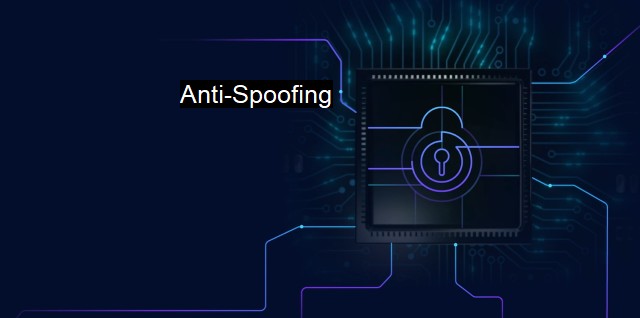What is Anti-Spoofing?
Preventing Spoofing Attacks: various anti-spoofing techniques and their application in cybersecurity"
Anti-spoofing, primarily referenced in cybersecurity and antivirus realms, represents one of the crucial strategies employed to deter cybercriminals from running malicious activities. It's centered around the practice of identifying and blocking data packets that have disguising or spoofed source addresses, aiming at the illegal entry into systems, networks encompassing individual users and organizations alike. To understand anti-spoofing fully, one must comprehend the process, significance, and the various types employed as defensive mechanisms against spoofing cyberattacks.Spoofing, from which anti-spoofing takes its name, is a fraudulent practice where an intruder disguises communication from an unknown source as it's coming from a trusted source. These actions can occur in several scenarios: email spoofing, where cybercriminals mock the email sender's address to appear legitimate; IP spoofing, where the attacker masks their internet protocol address or exploits a trusted IP address to leverage an assault; and caller ID spoofing, where fraudsters forge the caller ID to indicate a specific number.
The inevitable question is, why do cybercriminals employ spoofing? The answer lies in the desire for unauthorized access to systems, stealing personal data, identity theft, gaining financial information, or distributing malware and viruses. Thus the phenomenon of anti-spoofing was conceptualized, designing prevention systems to identify and repel potential spoofing attacks actively.
Anti-spoofing deploys a series of techniques ensuring robust defense networks. One prominent method is the IP anti-spoofing, a strategy suppressing traffic from impostor IP addresses. Employing ingress filtering by enforcing access control lists on routers and firewalls ensures any packet from unrecognized or invalid addresses does not penetrate the network. Conversely, egress filtering examines outgoing traffic, stopping any data with a spoofed address from exiting the system, thus preventing the network from engaging indirectly in Distributed Denial-of-Service (DDoS) assaults.
Utilizing verification methods such as Cryptographic Network Protocols would help validate the source of the traffic. These cryptographic techniques, including Secure Sockets Layer (SSL) and Transport Layer Security (TLS), encrypt information in traffic, ensuring secure data transfer and impeding potential threats.
In email-related spoofing, anti-spoofing strategies involve investigating an email's origin, verifying it against the supposed sender's established criteria. Techniques like Sender Policy Framework (SPF), Domain-based Message Authentication Reporting, and Conformance (DMARC), and DomainKeys Identified Mail (DKIM) authenticate the sender's email, reinforcing email security and preserving enterprise reputations.
Irrespective of the type of anti-spoofing technique adopted, it needs to constantly adapt and evolve. For instance, in a PTR (Pointer) record, a Reverse DNS lookup authenticates the originating IP address of an email. If no corresponding PTR record is found for a piece of ID data, it deems it suspicious. Thus, consistent scrutiny and updating of DNS records is mandate.
In the context of antivirus solutions, many incorporate anti-spoofing mechanisms as a part of their security suite, contributing a significant chunk in the cybersecurity defense. Antivirus software achieves this by continuously updating virus definitions that include potential phishing threats and malware. This proactive action alerts users about suspicious activities, ensuring that harmful software can't infiltrate the system, thus fortifying the defense against potential spoofing attacks.
Anti-spoofing is no more an accessory; it's necessary for maintaining a formidable cybersecurity infrastructure. It mitigates the cyber-threat posed by spoofing, excessively used as an infiltration technique by cybercriminals. By identifying and disallowing traffic from disguised sources, organizations ensure the integrity of their systems, safeguard crucial data, and protect themselves from potential financial losses.
In an ever-evolving landscape of cyber threats, awareness and appropriate defense strategies are pivotal. Therefore, considering anti-spoofing doesn't just shield against cyber-attacks but fosters trust and confidence in institutional and personal digital transactions. Hence, it's worthwhile to invest in appropriate anti-spoofing measures, contributing significantly to the broader ambitions of data privacy and security in the digital age.

Anti-Spoofing FAQs
What is anti-spoofing in cybersecurity?
Anti-spoofing is a cybersecurity technique used to prevent attackers from impersonating legitimate users or devices on a network.Why is anti-spoofing important in antivirus software?
Anti-spoofing is important in antivirus software because it helps to prevent the spread of malware and viruses. By detecting and blocking spoofed traffic, antivirus software can prevent attackers from exploiting vulnerabilities in the network.What types of spoofing attacks can anti-spoofing prevent?
Anti-spoofing can prevent a variety of spoofing attacks, including IP spoofing, MAC address spoofing, and DNS spoofing. These attacks allow attackers to masquerade as legitimate users or devices, which can be used to launch further attacks or steal sensitive information.How does anti-spoofing work in practice?
Anti-spoofing works by analyzing network traffic and comparing it to a list of known legitimate devices or users. If a device or user is found to be spoofing its identity, the anti-spoofing software can block the traffic or alert the network administrator. Some anti-spoofing techniques include IP address filtering, MAC address filtering, and ARP spoofing detection.| | A | | | B | | | C | | | D | | | E | | | F | | | G | | | H | | | I | | | J | | | K | | | L | | | M | |
| | N | | | O | | | P | | | Q | | | R | | | S | | | T | | | U | | | V | | | W | | | X | | | Y | | | Z | |
| | 1 | | | 2 | | | 3 | | | 4 | | | 7 | | | 8 | | |||||||